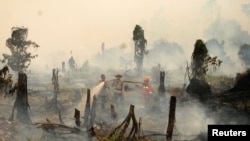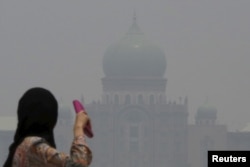Indonesia's Disaster Agency said it is confident the country's forest fires and haze of toxic smoke they send over Southeast Asia are unlikely to reach levels seen in 2015 because of favorable weather conditions and a quicker emergency response.
Last year's fires were among of the worst on record, straining relations between Indonesia and its neighbors, and costing the country at least $16 billion in economic losses, equivalent to 1.9 percent of its gross domestic product, according to the World Bank.
"We are certain this year things will be better," agency spokesman Sutopo Nugroho told reporters Monday, referring to a 61 percent reduction in hotspots seen in 2016 compared with a year ago.
Six Indonesian provinces have declared a state of emergency, allowing the agency to respond more quickly than last year, Nugroho said.
"In 2015, only three provinces declared a state of emergency and even that was too late. The forest and land fires had already spread," he said.
Home to the world's third-largest area of tropical forests, Indonesia has been criticized by green activists and by neighboring Southeast Asian nations for failing to stop the region's annual haze, largely caused by forest-clearing for palm and pulp plantations.
The pollution in 2015 cost Southeast Asia economic powerhouse Singapore S$700 million ($517 million), the country's environment and water resources minister said in March.
An unusually wet dry season linked to the La Nina weather phenomenon this year has helped stop fires from spreading, Nugroho said.
Based on weather forecasts, the dry season will peak in September and end in October, Nugroho said.
"So for that one month we will really keep everything under control," he said.
Singapore on Monday got a break from the haze that hit the island state last week, as shifting winds pushed the smoke from Indonesia's Sumatra island northward over Malaysia.
There, air quality in Kuala Lumpur neared "unhealthy" levels and residents took to social media to complain about poor visibility and an acrid smell.
Despite Indonesian President Joko Widodo's instructions to end the annual blight "the sooner the better," the problem won't go away without an improvement of preventative measures, Nugroho said.
"There is no way we can completely eliminate or end the forest and land fires in Indonesia, because they are very much linked to behaviors of communities that light fires," he said, referring to farmers who use fires to prepare land for crops and clear it for plantations. "There are still fires, so prevention needs to be improved."
According to the World Bank, about 35 percent of the Indonesian workforce is employed in agriculture, with palm oil and pulp-and-paper industries key contributors.
Palm oil is a major growth driver for Indonesia, the world's biggest producer of the edible oil.










